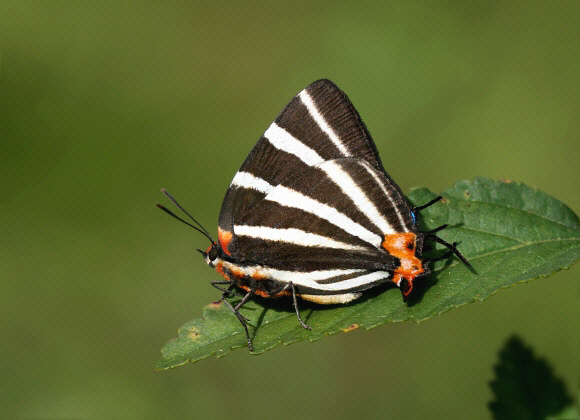
Introduction
Almost all neotropical Theclinae species are placed in the Eumaeini. The tribe is not particularly well represented in collections, so until fairly recently a high percentage remained unstudied, and were inappropriately filed away in the ‘convenience’ genus Thecla. Many taxonomists have attempted to rationalise the systematics of the Eumaeini, the most recent being Robbins who published a revision in 2004, reclassifying the taxa into 83 genera. Currently there are 1058 known species. Taking into account their small size, secretive behaviour, and the great similarities between many species, it is estimated that about another 200 species probably remain to be discovered.
There are 8 Panthiades species distributed variously from Mexico to Brazil. The uppersides of males are an intensely reflective deep blue colour, with narrow black margins and a prominent patch of dark androconial scales in the cell of the forewing. Females are a paler and less metallic shade of blue, with broad suffused dark margins. On the underside, two species – bathildis and phaleros have black and white zebra patterns. Most of the other species have dark undersides marked with large white suffused patches and black venation, the exceptions being bitias and hebraeus which have plain undersides with a single narrow ‘hairstreak’ line.
The striking zebra pattern of bathildis serves to divert the eyes of predators away from the head and body of the butterfly, and towards the ‘false antennae’ tails. It creates a ‘back to front’ illusion that deceives lizards and birds, tricking them into aiming their attack the wrong part of the butterfly. The predators typically try to increase their chances of a direct hit by aiming their attack just ahead of where they expect the butterfly to fly, but are fooled into aiming behind, instead of in front of the target. The result is that the butterfly is able to make its escape in the opposite direction.
Panthiades bathildis is distributed from Mexico to northern Brazil.
Habitats
This species is found in forest edge habitats at elevations between about 500-1800m.
Lifecycle
To be completed.
Adult behaviour
Males are invariably encountered singly, perching or resting on foliage, boulders or fallen tree trunks. The flight is rapid, erratic and difficult to follow with the eye, but the butterflies invariable return to settle on their original perching place, or on another nearby leaf or boulder.
